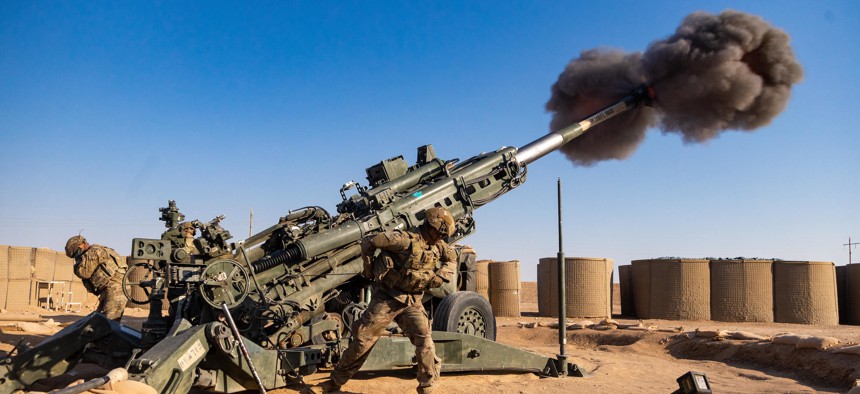
U.S. soldiers conduct registration and calibration for the M777 A2 Howitzer weapon system in Syria on Sept. 30, 2021. U.S. Army photo by Cpl. Isaiah Scott
How Much Can US Howitzers Help Ukraine?
Everybody’s talking about the fabled long-range guns. Here’s why.
As Russian forces focus on seizing Ukraine’s Donbas, the United States has begun rushing 90 howitzers—the famed 155mm artillery guns used by the U.S. Army and Marine Corps—to help repel the invaders in the flat, largely rural region. But how much will they help?
“Artillery is a specific item that the Ukrainians asked for because of the fighting that they expect is going to occur in the Donbas,” Pentagon spokesman John Kirby told reporters April 18. “The terrain lends itself to the use of artillery, to long-range fires, as we call it. And we know that the Russians also believe the same thing, because we're seeing them move artillery units into the Donbas as well. And so we want to give the Ukrainians every bit of advantage that we can.”
The need—if not the exact circumstances—has been foreseen for several years by senior U.S. military and defense leaders, who said the Pentagon itself would need more artillery to deter Russian and China. The Army has called new artillery a priority since 2017. But U.S. service leaders have since argued over who should get the mission, and the money.
One year ago, a top Air Force general argued that the job and the funds should belong to his service. “I just think it’s a stupid idea to go and invest that kind of money that recreates something that the [Air Force] has mastered and that we’re doing already right now,” said Gen. Timothy Ray of Global Strike Command.
Some scholars agreed, arguing that the Army was wrong to request so much new surface-to-surface weaponry. Then-Vice Chairman of the Joint Chiefs Gen. John Hyten, an Air Force general himself, weighed in to say that it was important that all service branches had the coveted capability.
The Air Force’s argument, however, appears to have left out at least one consideration: the defensive needs of U.S. allies and partners. Now the United States is sending two military assistance security packages that include 90 155mm M777 howitzers from the Army and Marine Corps, and thousands of rounds of munitions for Ukrainians to fight Russian forces. President Joe Biden is not sending the U.S. Air Force.
Here’s a look at why these artillery pieces are a top request by Ukraine and how they are used on the battlefield.
What is a howitzer?
The 155mm howitzer is the longest-ranged of the military's indirect-fire guns, able to hit targets up to 18 miles away. The U.S. operates two types of 155mm howitzers: the towed M777 and the self-propelled M109 Paladin howitzer. (The latter is not being sent to Ukraine, but is the basis of the Army’s Extended Range Cannon Artillery program, which has hit test targets 70 kilometers away.)

The M777 is operated by a team of about 10 people as part of a group of up to six guns called a battery. Artillerymen can set the range of their volleys by adjusting the amount of propellant used. They can fire each gun up to four times a minute, choosing from among unguided, precision-guided, high-explosive, and illumination rounds.
The M777, which can be towed behind a truck or sling-loaded under a helicopter, is currently used by the Army and Marine Corps, as well as the militaries of Australia, Canada, and India.
How are howitzers used in battle?
Howitzers are key to American combined-arms operations—ones that bring forces like infantry, artillery, and aviation to fight together. M777s have been used in Afghanistan, Iraq, and Syria by American forces.
For Ukraine, the artillery, in combination with counter-radar capabilities and drones, will be a “pretty significant addition to the Ukrainian capacity to fight,” said Brian McKiernan, a retired major general and former commandant of the Army’s field artillery school. He currently works as a consultant with Cypress International.
The Pentagon is planning to send enough howitzers to equip five battalions, Kirby said Thursday.
Ukrainian forces have had great success using Javelin missiles against Russian tanks within their line of sight. But long-range artillery like howitzers would allow Ukrainians to fire on those tanks, their supply lines, and other Russian military targets from a distance.
Don't miss:
“What this provides for the Ukrainian forces is lethal long-range fires that are very effective against everything from lightly armored vehicles to support vehicles, and in particular the Russian indirect fire system, their artillery and rockets,” Kirby said.
Howitzers are versatile, McKiernan said. Their long range allows a battery to fire on various targets without moving. They can slow or stop an enemy offensive or pave the way for a friendly one. They can technically even be used for direct fire, pointing directly at a target, but that’s not their intended use, he said.
“I think this would be a critical capacity,” McKiernan said. “Like I said, it really provides the Ukrainian forces with a lethal, long-range fires capability that gives them standoff [range] against the enemy, and [is] very effective against those targets sets, like light armored vehicles, support vehicles and Russian artillery. And I think, you know, would be a significant contributor to blunting a Russian offensive capability.”



